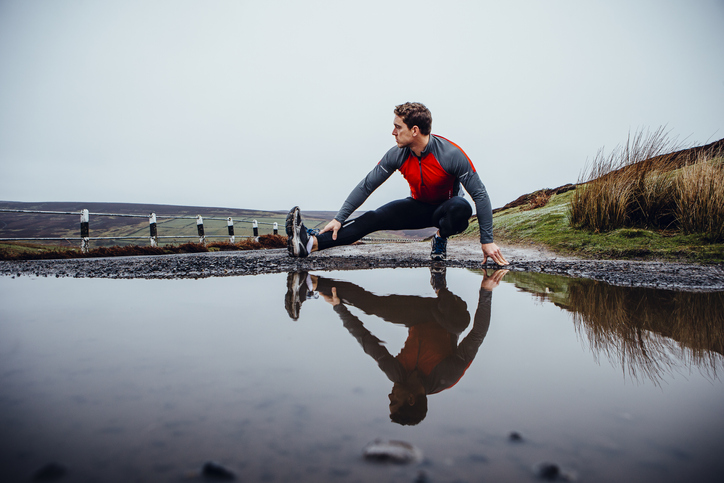The simplest solution to common running injuries is to avoid them in the first place, keeping daily temporary aches, pains, twinges or warning signals from becoming an actual injury, or keeping a small injury from becoming a major setback.
I could potentially get a running injury every day if I didn’t listen to my body, as there are always one or more problem areas of tight or sensitive muscles, tendons, ligaments or joints. When I sense those, I do common-sense things to avoid injury. First, a very slow, gradual warm-up on soft surfaces, as the muscles warm up and the joints lubricate. Then, stop briefly for a minute or two to do various loosening-up exercises around all the joints (but never doing typical “stretches” on cold muscles, for instance the standard wall-lean to stretch the calf and Achilles).
Before you head out the door do the following several times:
- Rotate each foot around the ankle joint in both directions
- Bend and extend each knee back and forth
- March in place to loosen up the hip area
- Alternately extend each leg on a short (2 ft.) object and lean forward, rocking gently back and forth (this is similar to the hurdlers stretch but your front knee is bent, your back leg is straight and hands are on thighs)
- Rotate the arms forwards and backwards around the shoulder joint (similar to the freestyle and backstroke move in swimming, with some butterfly mixed in).
- Rotate the neck in both directions to help relax the shoulders.
Additionally, to avoid injury, applying heat with a moist-heat wrap is useful before the run, using a massage stick on the calf, thigh, hamstring or lower back, or using the hands and fingers to massage the foot, calf, upper leg or lower back, are all important.
Sometimes, when you sense something wrong, just the act of stopping for a minute or so can be enough for the muscle or tendon to relax and the temporary pain to go away, avoiding an actual injury. Similarly, dramatically slowing your pace, or doing one of the suggested loosening-up exercises can relieve the problem. For a multitude of injuries, whether the calves, quads, hamstrings or lower back, I find that shortening the stride substantially will resolve the problem. Overstriding is one of the most common running form mistakes.
When you first develop problems anywhere from the feet to the hips, the first thing to look at is your running shoes, whether they’re worn out and need to be replaced, or if you need a different model of shoes. A vigorous sports massage or physical therapy session targeting various “trigger points” can also help to alleviate problems.
And finally, heeding the saying “a stitch in time saves nine,” by taking one to three days off from running can often stop an injury in its tracks. Although it’s common for a non-running doctor to simply say take three weeks off in response to most injuries, I’ve found from experience that more than three days are rarely necessary. During the days off, depending on the problem area, non-impact cross training (swimming, exercise bike, stair stepping or elliptical) can often allow fitness to continue.
Most importantly, never mask the body’s warning signals by taking pain medications, and never try to run through the pain, whether in a workout or in a race. Many runners have created long-term or even career-threatening injuries by continuing to run when they should have stopped. There’s no honor in completing a half marathon or marathon when it keeps you from running for the next few months.

